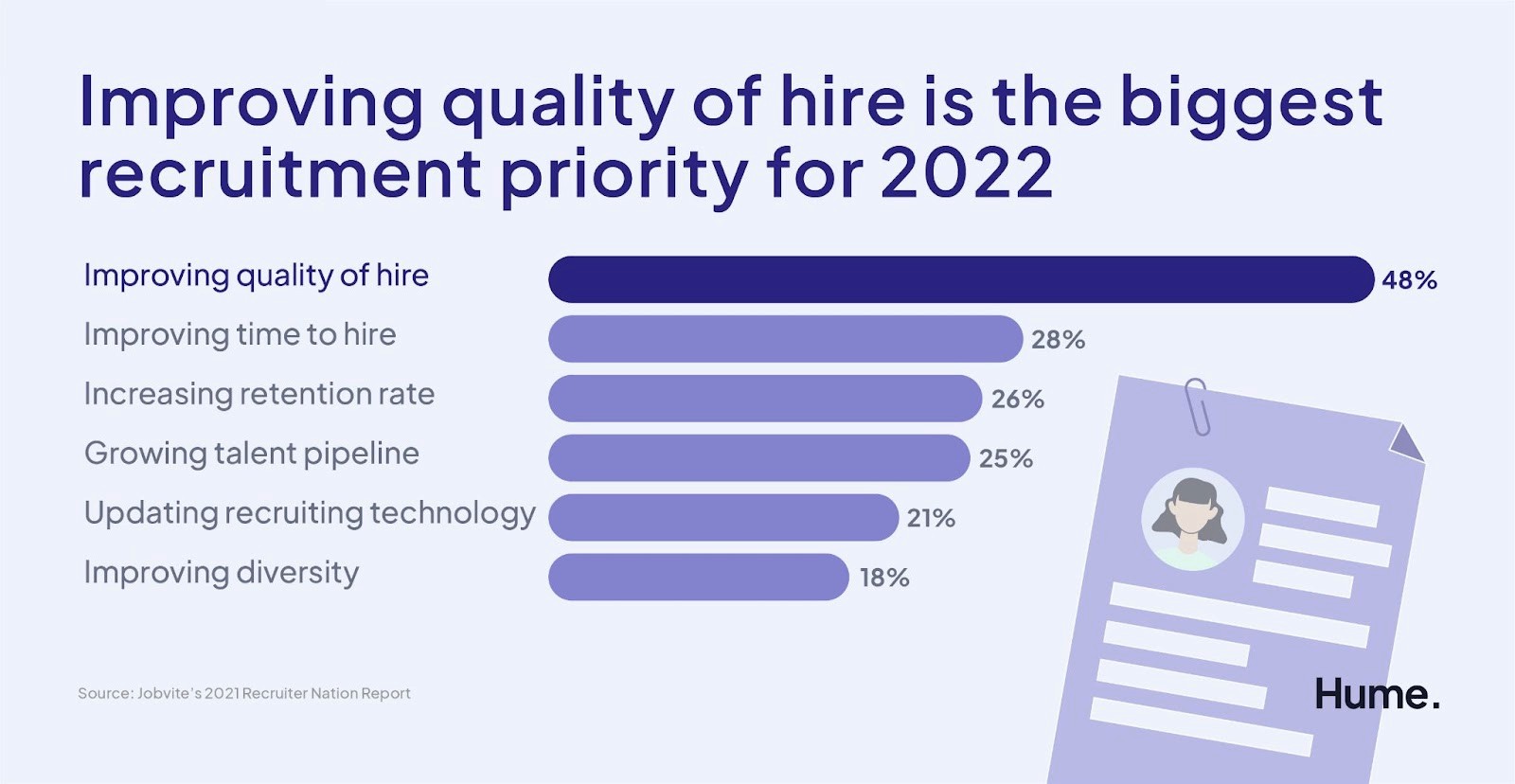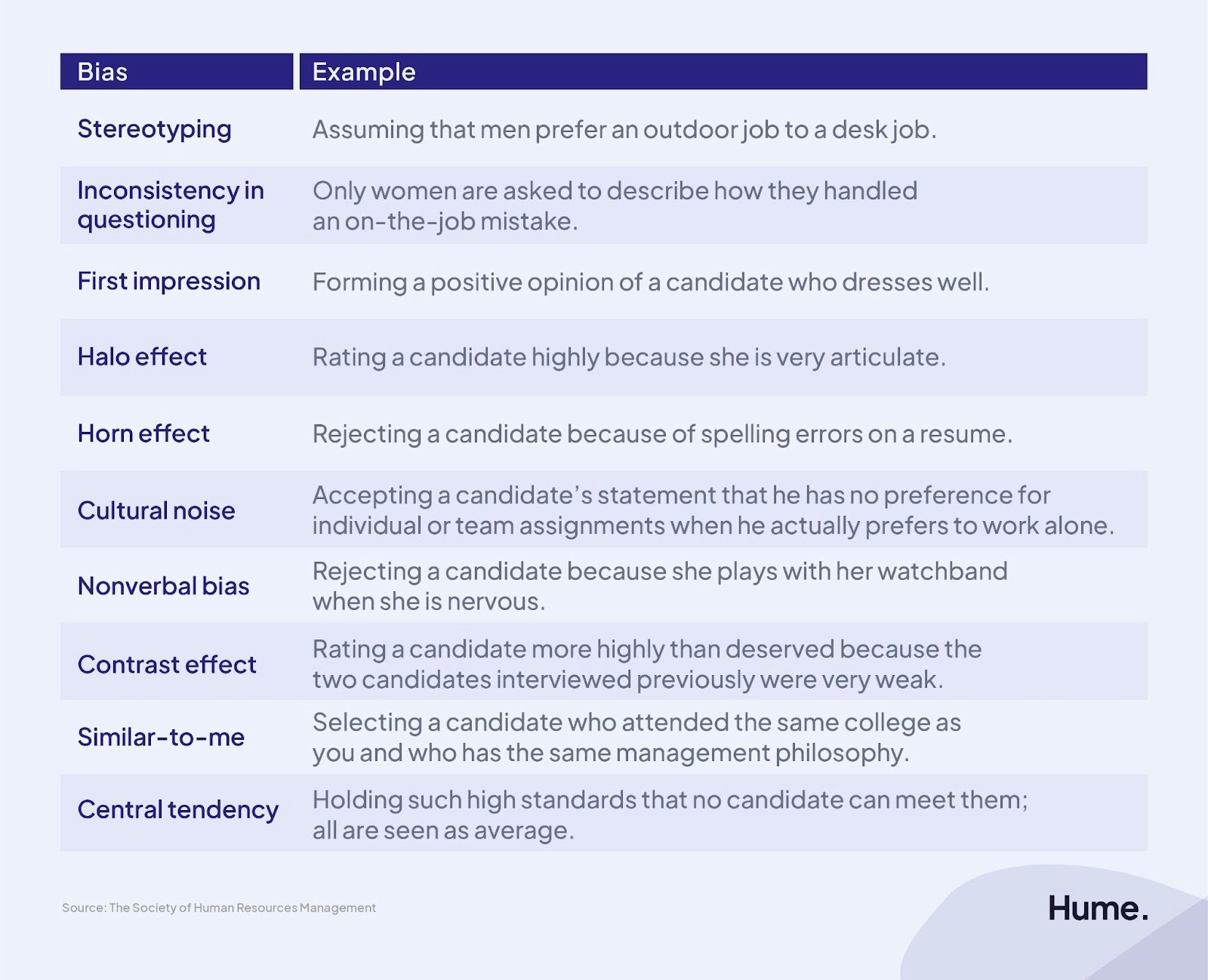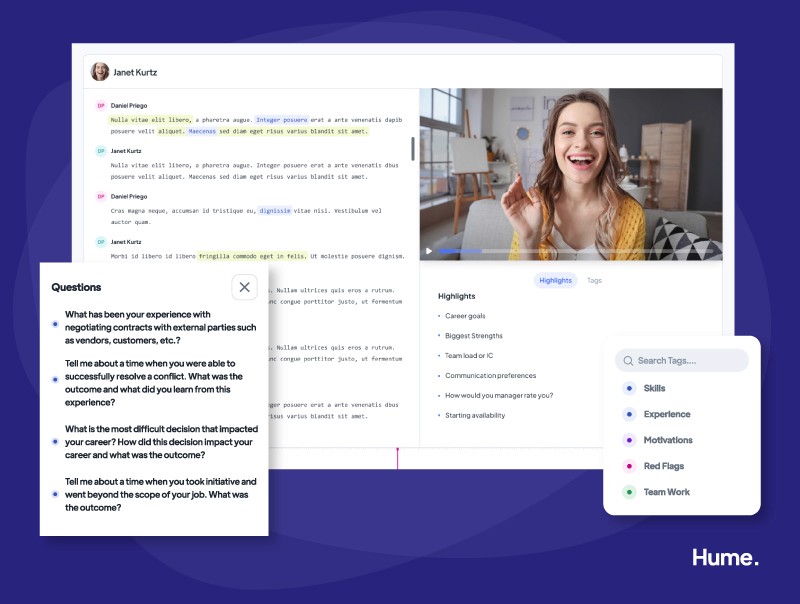7 Creative Ways to Identify a Great Candidate
Learn about 7 interesting tactics that will help you identify great candidates and 1 interview tool that will help you make evidence-based hiring decisions.
5.0

Add an AI assistant to your interviews
Start with 5 interviews for free
Already have an account?
Log in
In this day and age, wise candidates enter interviews knowing how every beat of the process will go.
First, they’ll pull up a conference room chair, make charming small talk about traffic or the weather, and dive into reviewing their obviously spotless resume (why would they put anything unfavorable on there?).
And after answering the same predictable questions about where they see themselves in five years and their biggest weakness (I just love working too much!), they’ll hand over a highly groomed list of references and walk out confident that a job offer will be extended.
So what can you do as a hiring manager to determine if you’ve got an exceptional candidate in front of you — or just one who is really good at going through the motions?
You have to get creative.
In this article, we’ll share some fresh new ways to identify great candidates, including:
7 interesting tactics that will unveil a candidate’s true character (during and sometimes even before the interview)
1 cutting-edge interview tool that will provide the data you need to make evidence-backed, unbiased hires
Let’s get started separating the best candidates from the rest of the crowd!
7 original strategies to help you spot good candidates during the hiring process
Quality of hire is the single most critical metric for hiring personnel in 2022.
Why? Because while at surface level it’s a measure of employee performance, it’s also a powerful insight into how well your recruiting and hiring methods are meeting your needs!

If you’ve been measuring quality of hire (and if you haven’t, you should be!) and repeatedly finding that new hires aren’t performing at the desired level, it’s time to change up and step up how you’re finding and choosing candidates.
So we’re here to help you do just that. In this section, we’re going to walk you through seven interesting new strategies that you can use to spot candidates who are great for your company — not just the ones who are great at doing job interviews.
1. Shake up the interview setting
One of the easiest things you can do to see who candidates truly are in day-to-day life is to interview them in a way that’s more accurate to daily life. That means breaking away from the traditional conference room table at some point in the initial interviewing stage.
The simple version of this strategy is taking candidates on a tour of the building in which they’ll be working. While doing so, you can observe how they interact with the world at large, and with your team in particular. Are they curious, are they attentive to the unique elements of your business, do they treat others with interest and respect?
To take this strategy to the next level, we recommend having a meal with the candidate! In this setting, it’s less about asking job-specific questions and more about observing their real-life character. Are they polite to workers and other patrons, can they keep up with a less predictable conversation, are they easily flustered? The way they behave here shows the habits they’ve developed throughout their life — and that will eventually come out in the workplace. You want the chance to make sure those mesh well with the role and your overall culture before moving forward.
To quote publishing leader Carol Smith: “You learn so much in a meal. It’s like a little microcosm of life.”
2. Ask: how well did the candidate interview you?
Candidates that realize interviews go both ways are unique.
A great candidate doesn’t just answer your questions and say “I think we covered it!” at the end of the interview. A great candidate interviews you.
Great candidates listen and synthesize information throughout the interview. They ask thoughtful questions. They dig deep to make sure that they understand what’s expected of them in the role and at the company. This is a sign of a great candidate with self-awareness and self-respect. They know enough about themselves that they know what questions to ask to ensure they can excel. And it’s a great sign if they want to excel, because that indicates they take the job seriously and intend to stick around long enough to make an impact.
Pay attention to the questions a candidate asks, or how they interview you. This is one of the best strategies for determining how they think, how fast they process information, and how invested they plan to be in the role.
3. Remove implicit bias to attract diverse job seekers early in the recruiting process
Diversifying your team is the straightest path to injecting innovative and creative perspectives into your business. These features are more important than ever in the disruptive world in which we live, where the companies that are creating their own playbooks are the ones that are succeeding.
We’ve talked a lot about interview bias because it’s a genuine issue that interviewers run into. But how do we get people with diverse perspectives into interviews in the first place? We have to use clever strategies to eliminate implicit biases earlier in the recruiting process.
There are a few ways to get past the issue of subconsciously hiring people who look like you — or like the majority of your team — over and over again:
Review job description: Are you accidentally using biased language that’s only speaking to a specific audience segment in your job posting? Get a second opinion and try a tool like textio to switch up your wording and attract a more diverse group of applicants.
Think about the skills and experience you’re seeking: You might think you’re doing the right thing by looking for candidates with a particular skill set, but when you do so you’re limiting the types of people who will feel comfortable applying. Consider broadening the kinds of experience and skills you’re looking for to draw a more diverse crowd.
Kick it old school with phone interviews: A lot of implicit bias kicks in when we meet someone in person for the first time. To help make sure you’re interviewing and hiring based on character and fit instead of first impressions, host preliminary interviews via phone instead of video or in person.

“I’m always looking for the opposite of what I am, for the most part,” said independent director, strategic advisor, and former president of the WNBA, Lisa Borders. “I think so many of us, because of unconscious bias, hire people who look just like us, who have the same skills that we do, to complement us. That’s not a complement at all. That’s a duplicate. So I am often looking for the person who can complement the skills I already have.”
4. For a great candidate experience during an interview, ask about hobbies
We love this imaginative tip from America the Bilingual Project founder and Levenger chairperson and co-founder, Steve Leveen: ask about hobbies, like collecting!
When Steve is involved in the hiring process, he always asks if the candidate collects anything. For him, it’s a way to separate the good candidates from the great ones. Great candidates will be so passionate about learning that they pursue it on their own, through hobbies outside of work.
“It doesn’t actually matter what they collect,” said Steve. “Just that they are really interested in something, that they have passions.”
5. Consider the candidate’s level of interest
When you have a list of candidates who are nearly identical on paper, you have to get inventive to identify and hire the top talent of the bunch.
A simple, but overlooked, way to do so is to consider the interest level of each candidate.
A candidate who’s truthfully interested in the role and your company will make that known. They’ll be happy to make interviews happen, they’ll be engaged during the process, they’ll ask questions enthusiastically, and they’ll promptly follow up after interviews to see where they stand.
In 2022, it’s an employee’s market. Authentic excitement about a role shouldn’t be overlooked when it comes to identifying the best fit for a job.
6. Review resumes for hints about cultural fit
Developing interview questions that help you identify good cultural fits is a noble pursuit — but it’s also a tip you’ve heard time and time again (we’ve even been known to mention the value of cultural fit!).
So we’re going to suggest a tactic that goes in a different direction, is pretty easy to pull off, and can be done before even conducting an interview — just look at the candidate’s resume!
You already know a good candidate will personalize their resume to show off the roles and workplaces they most want you to focus on. So take a look at what it is they want you to see! Did they choose to highlight roles where they were more of a leader, or more of a collaborator? Do they tend to accept jobs at bigger or smaller organizations?
When you consider the things a candidate’s resume tells you about their workplaces preferences, you’ll have a pretty good idea of how they’re going to align with your company culture before even meeting them in person. An ideal candidate will have a resume that hits all the points you’re looking for on the culture front.
7. Get a vote from the people with whom they’ll be working
CEO of biopharmaceutical company OptiNose, Peter Miller, has their greatest applicants do one final thing before making a hiring decision: he has them run the gauntlet.
Luckily, it’s not as scary as it sounds.
What Peter is referring to is having a candidate meet as many as 20 different team members within his company — mostly those with whom the candidate will interact at some point. At Peter’s company, every one of these people has veto power. While we don’t think you necessarily need to take it that far, we do love the idea of getting more opinions in the mix — which can take care of blind spots and mitigate any accidental biases.
How to use Hume to bring evidence to the interview process
Did you notice the one thing almost all of the above creative tactics hinged on?
The interview process.
Interviewing is critical in identifying and hiring great, well-fitting candidates.
However, when done the traditional way, there is a lot of room for inconsistencies and personal opinions — conscious and otherwise — to sway interviews and hiring.
What modern hiring professionals need is a tool that turns interviews into evidence, which teams can then use to make data-based hiring decisions.
What modern hiring pros need is Hume.
Hume is an interview companion that talent leaders can use to record, automatically transcribe, and add tags to interview conversations. Interviewers can even create highlight reels of essential interview moments and share ‘em with the rest of the hiring team — all inside the Hume platform!
Hume removes distractions and biases from the equation by empowering interviewers to fully engage in candidate conversations, not worry about taking detailed notes and rely on inaccurate impressions and recall. Thanks to the smart tagging features, interviewers can also use Hume to ensure they’re asking consistent questions, making it easier to compare candidates evenly and equitably — and ultimately hire top talent!
With a robust metrics dashboard that provides insights on time spent talking vs. listening, questions asked vs. questions answered, and more, hiring teams can use Hume to nail down the cadence and questions that make for a successful interview. This information makes it possible to create training resources that will actually make your hiring team more successful.
And speaking of training resources, Hume can also help with those thanks to our hiring manager training features. Just pop open the playlist tool to create, save, and share coaching videos quickly. Shape your team into top-tier interviewers and ensure you’re able to close great candidates with training sessions on overcoming biases, asking consistent questions, identifying cultural fits, and other best practices.

To capture the data you need to make the most equitable and diverse hiring decisions — add Hume to your technology roster.
Visit our website to sign up for access to Hume and follow us on LinkedIn to keep learning how to use Hume’s interview companion to help identify and hire great candidates.
Imagine transforming every interview into a strategic advantage. Dive deep into every conversation, free from the distraction of note-taking. This isn't just wishful thinking – with Aspect, it's how you'll redefine your hiring process.
Beatriz F
People Success Specialist
Absolutely game-changing for busy recruiters!
The summary, the Q&A feature and the ATS integration have boosted my productivity and lowered the context-switching stress, the analytics provided allowed for me and my team to have full visibility over our stats, and Aspect's team couldn't be more helpful, friendly and accessible!
More Content On Talent Acquisition

